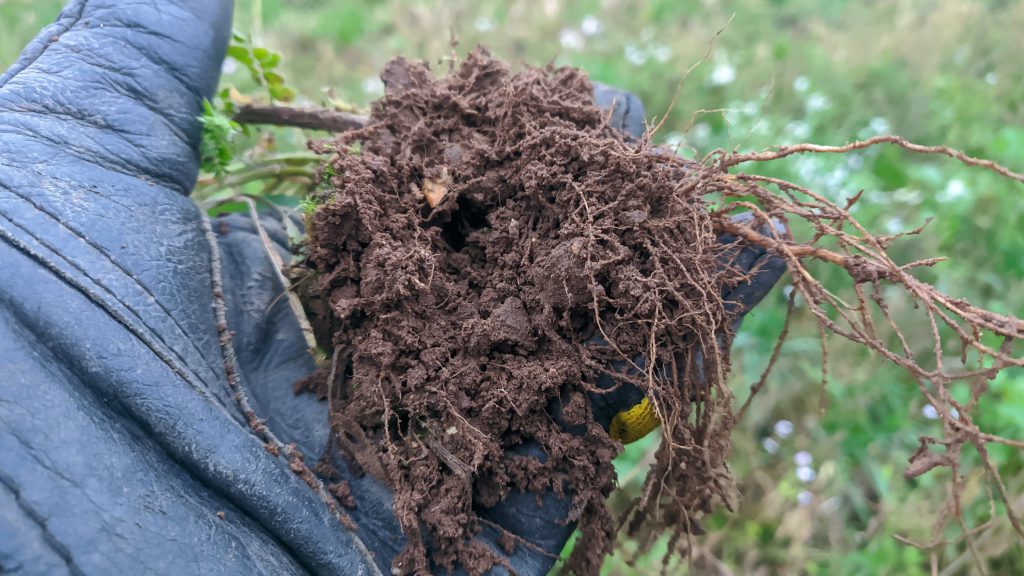
Fixing our soils

The flooding and erosion we experienced over last winter showed us that the soil on Deepdale Farm was in need of attention. ‘Farmed out’ was one expression used, not the way we say we farm something out when we get someone else to do a job, but that the soil had literally had the goodness farmed out of it.
Deepdale Farm, like many others, has been farmed intensively for many years, to produce wheat, barley, sugar beet, carrots, potatoes, maize, parsnips and more. Growing root crops, in particular, has been detrimental to our soil quality. Fields have been de-stoned to provide the right growing conditions for straight carrots, the soil has been intensively cultivated, irrigation has washed out soil structure and artificial inputs have been used for crop nutrition rather than organic materials.
The farm has been productive, but this productivity has come at a price. We’ve seen deterioration in soil quality which was a major factor in the erosion and flooding we experienced, and apparently an ever-greater dependence on the bag and the bottle. It says something when your agronomist works for a chemical company and even they are telling you that you need more organic matter in your soil, as ours did earlier this year.
This is a situation being seen on farms all over the world. A recent study of farms in 38 countries on six continents found that 90 per cent of the conventionally farmed soils in the study were thinning.
…our soils and landscapes have been catastrophically degraded by previous agriculture policies that incentivised intensive food production
Martin Lines, Nature Friendly Farming Network report ‘Nature Means Business: Establishing the Balance Between Food Production and Improving Nature‘

Things came to a head for us as we were still finding our feet with the farm. As rainfall continued in the wettest February for ten years and we saw our soil washing into a neighbour’s cellar and the village church, we knew that something had to be done.
Dirt to Soil

We’re not alone at Deepdale Farm in having taken a lot from Gabe Brown’s book, Dirt to Soil. A farmer in Bismarck, North Dakota, Brown has become an advocate for a set of practices widely known as ‘regenerative agriculture’ that have gained much wider acceptance in the last few years. The principles of soil health he lays out at the beginning of his book are as follows:
- Limited disturbance – tillage destroys soil structure, affecting the organisms that build soil fertility and the aggregates and pore spaces that allow water to infiltrate the soil.
- Armour – soil should be covered at all times (nature doesn’t leave soil uncovered). Covered soil is protected from erosion, habitat is provided for organisms, moisture evaporation is reduced and weeds are suppressed.
- Diversity – monocultures don’t exist in nature. A diversity of plant species provides a rich and useful mix of root structures and functions such as nitrogen-fixing and carbon-building.
- Living roots – living roots feed soil biology which in turn fuels the nutrient cycle that feeds plants. This naturally happens throughout the year.
- Integrated animals – grazing improves the function of soil biology and cycles and processes nutrients. Animals such as pollinators, predator insects, earthworms and countless microbes all have an essential role.
All change
At Deepdale Farm we have started the process of fixing our soils, in various different ways including
- Testing our soils to better understand their makeup and health
- Connecting with soil health experts, Norfolk FWAG, Norfolk Rivers Trust and other farmers and land managers to learn and share ideas
- Converting to organic farming, which means removing all synthetic fertilisers, herbicides, fungicides and pesticides from our farm and using inputs of organic origin and biological pest controls as well as crop rotations focussed on soil health and natural fertility building
- Making use of cover crops including undersown cover crops and fertility building clover leys
- Massively scaling down the amount of land we farm, putting 60% of the farm into environmental features and taking problematic and unproductive fields out of production altogether
- Changing our practices on the farm including reducing tillage and direct drilling
- Looking into bringing livestock into our arable rotation
- Diversifying our choice of crops, trying out more varieties and techniques such as intercropping
- Removing high-risk (root vegetable) crops from our rotation until we can find a way to farm them sustainably

We’re in the early days with many of these changes – for example, our organic conversion has just begun, meaning that we are farming organically and have stopped using artificial inputs across the farm – but conversion takes two years.

As we learn and develop what we’re doing, we’ll share more on our experiences. The next update will focus on our experience so far with cover crops, and the role they have to play in protecting and improving the soil.
Keep up to date
We’ll share more on the ways we’re working to fix our soils in future through this blog, the Deepdale Podcast and our social channels. Subscribe to keep up to date.
Related reading
- Coastal farm’s transformation will shift focus from food production to nature
- Challenging year is a catalyst for change
2 thoughts on “Fixing our soils”
Comments are closed.



[…] We’re hopeful that this puts us in a stronger position for the future. In any event, the changes we’re making on the farm were needed and are worthwhile. We just hope that ELM ensures these changes really are […]
[…] This is a longer read than usual, a follow-on from our post about fixing our soils. […]